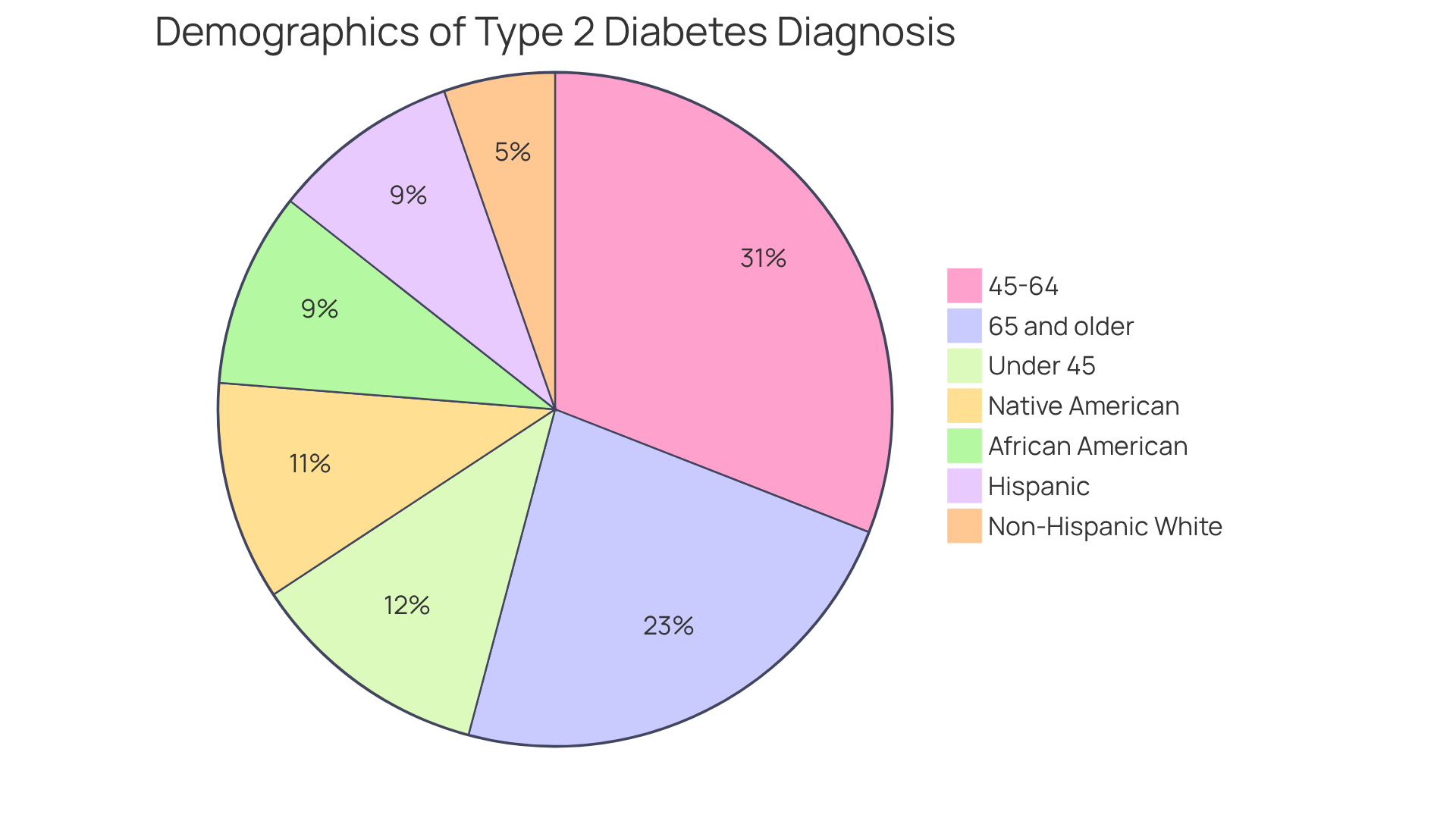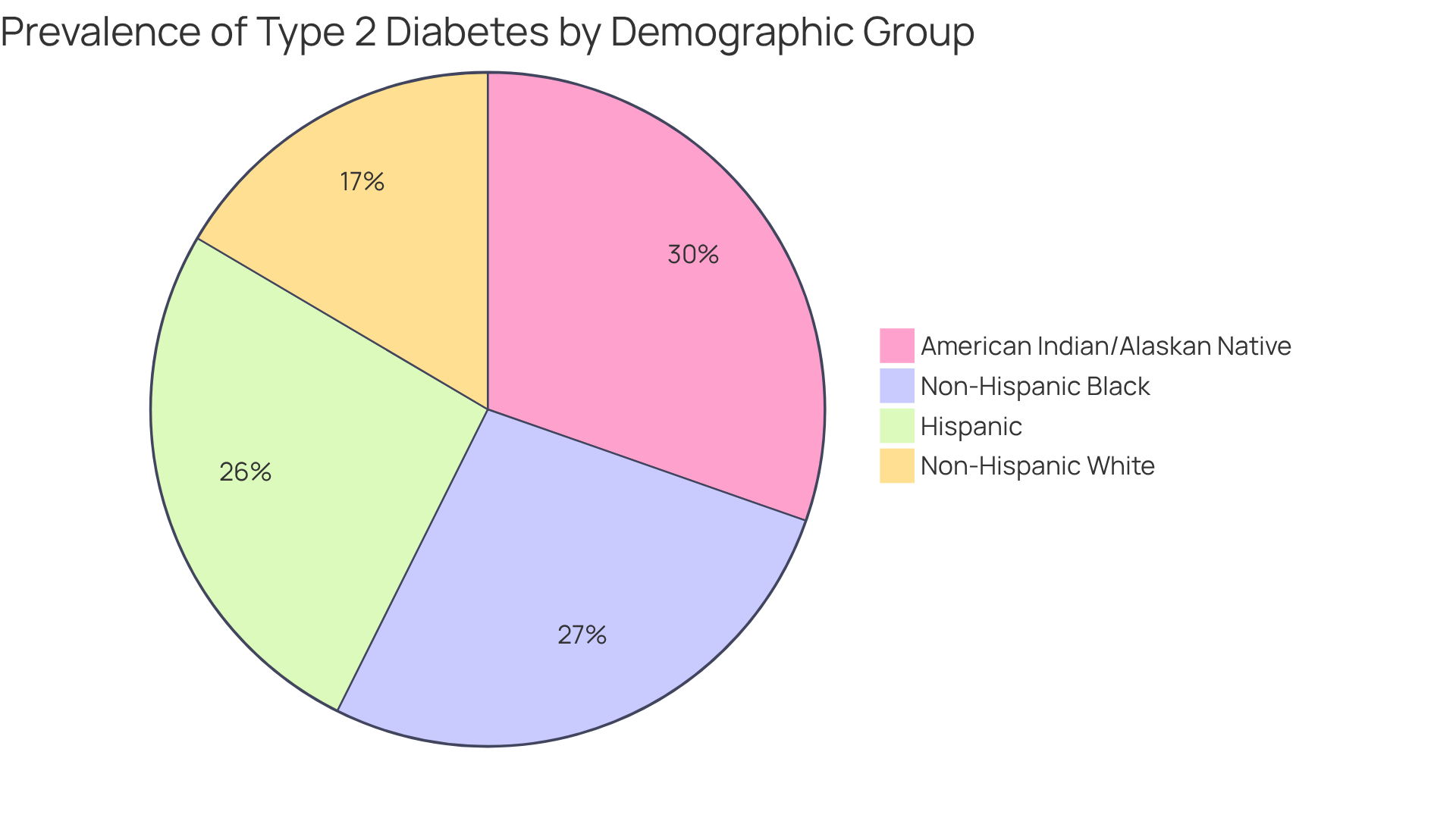Overview
This article seeks to understand the demographics of type 2 diabetes, shedding light on significant disparities in prevalence based on age, ethnicity, and socioeconomic status. It’s important to recognize that higher rates are observed in minority communities and among younger populations. This reality underscores the need for targeted interventions and culturally sensitive education to effectively address these disparities. You're not alone in this journey; together, we can work towards solutions that support those affected.
Introduction
Understanding the demographics of type 2 diabetes is essential for addressing the growing health crisis that affects millions globally. It’s concerning to see how this condition is impacting more individuals than ever before. This article delves into the critical statistics surrounding age, ethnicity, and socioeconomic factors, revealing alarming trends that signal a shift in who is most affected by this condition.
As rates of diagnosis rise among younger populations and minority communities, it’s understandable to feel overwhelmed. The question remains: how can healthcare systems adapt to effectively support these diverse groups and mitigate the impending public health challenges?
You're not alone in this journey; we are here to support you every step of the way.
Define Type 2 Diabetes Demographics
Understanding the type 2 diabetes demographics of individuals diagnosed with this condition is crucial. It encompasses various statistical characteristics, including age, gender, ethnicity, and socioeconomic status, which are all important aspects of type 2 diabetes demographics. Generally, this blood sugar condition is more commonly seen in individuals over the age of 45. However, it's concerning to note that rising rates are now being observed in younger groups, including children and teenagers.
Ethnic disparities are significant. The type 2 diabetes demographics indicate higher prevalence rates in African American, Hispanic, and Native American communities compared to non-Hispanic whites. It's essential to recognize these differences as they can inform how we approach prevention and treatment strategies.
You're not alone in this journey. Understanding type 2 diabetes demographics can help us effectively tailor support and resources. If you or someone you know is affected, consider reaching out for guidance and assistance. We are here to support you every step of the way.

Explore Prevalence Across Populations
The occurrence of condition 2 reveals significant variation in type 2 diabetes demographics among different groups, and it's important to recognize how this impacts lives. Worldwide, approximately 11.1% of adults are living with high blood sugar, with Type 2 high blood sugar accounting for over 90% of these cases. In the United States, the Centers for Disease Control and Prevention (CDC) reports that 14.7% of individuals are diagnosed with a sugar regulation disorder, and this highlights the type 2 diabetes demographics, which show notably higher rates among racial and ethnic minorities. The type 2 diabetes demographics show that:
- 12.1% of non-Hispanic Black individuals are affected
- 11.7% of Hispanic individuals are affected
- 7.4% of non-Hispanic whites are affected
- Alarmingly, 13.6% of American Indians/Alaskan Natives are diagnosed with glucose intolerance
This highlights the critical need for targeted interventions and culturally tailored strategies in communities, especially in relation to the type 2 diabetes demographics facing high prevalence rates.
At T2DSolutions, we understand the disparities within type 2 diabetes demographics and aim to address them by providing education and community support tailored to the needs of these populations. The economic strain of this illness is considerable, with at least USD 1 trillion in medical costs linked to the condition. It's concerning to note that the number of adults living with this condition has risen by 338% over the past 17 years, emphasizing the urgency for effective management strategies. Furthermore, this condition was the eighth leading cause of death in the United States in 2021, underscoring the importance of tackling its prevalence and implications for public health.
The average medical costs for individuals with diagnosed conditions related to blood sugar are 2.6 times greater than those without such conditions. This stark reality further demonstrates the financial consequences of this illness, affecting not only individuals but also the healthcare system. Remember, you are not alone in this journey; we are here to support you every step of the way.

Analyze Trends in Type 2 Diabetes Demographics
Recent trends indicate a concerning rise in type 2 diabetes demographics, particularly affecting younger individuals and minority communities. The CDC reports a nearly 20% increase in diagnosed cases among children and adolescents over the past decade. This highlights the urgent need for effective prevention strategies. It's understandable to feel alarmed by these statistics, especially knowing that 29.2% of seniors are diagnosed with this condition, which contributes to higher prevalence rates within type 2 diabetes demographics as older individuals are more susceptible to developing Type 2 diabetes.
Projections from the World Health Organization (WHO) are equally alarming. By 2030, the number of adults living with this condition is expected to rise significantly, with type 2 cases among young people projected to increase by about 700% if current trends continue. This emphasizes the importance of ongoing monitoring and intervention strategies that are tailored to demographic shifts. Moreover, research shows that minority youth are facing even greater rates of diagnoses related to type 2 diabetes demographics, underscoring the urgent need for focused public wellness initiatives directed at these communities.
The increasing occurrence of Type 2 conditions among young individuals highlights the significance of early education and proactive wellness measures. You're not alone in this journey; many are advocating for early intervention to alleviate this growing public concern. Additionally, the economic burden of this condition is substantial, with the total cost of diagnosed cases in the U.S. reaching $413 billion in 2022. This further emphasizes the urgency of addressing these trends.
At T2DSolutions, we advocate for a comprehensive approach to managing blood sugar conditions. This includes lifestyle modifications and mental health support, empowering individuals on their health journey. Remember, we are here to support you every step of the way. Together, we can navigate these challenges and work toward a healthier future.
Discuss Implications for Healthcare and Community Support
The implications of the type 2 diabetes demographics are significant, influencing healthcare delivery and community support systems. It’s essential for healthcare providers to recognize the diverse needs of various demographic groups, particularly type 2 diabetes demographics, to implement effective prevention and management strategies. Did you know that 90-95% of cases of the condition in the United States are Type 2? This statistic highlights the urgent need for culturally sensitive education initiatives that address the unique challenges faced by minority groups, particularly in relation to type 2 diabetes demographics. Research suggests that customized educational programs can lead to better wellness outcomes among various type 2 diabetes demographics, highlighting the necessity for culturally relevant resources.
Community support initiatives, such as peer support groups and local wellness workshops, play a vital role in helping individuals manage their condition more effectively. These programs foster a sense of belonging and shared experience, which is crucial for motivation and resilience. For instance, the case study 'Building a Supportive Community' illustrates how shared experiences can improve the management of the condition. By encouraging cooperation among healthcare professionals, community groups, and individuals affected by Type 2 conditions, we can create a comprehensive support system that enhances wellness results and improves the quality of life for those managing Type 2 issues.
Looking ahead to 2025, the emphasis on community involvement and culturally appropriate resources will be crucial. It’s concerning that more than 4 in 10 adults with the illness are unaware of their condition. By integrating these elements into diabetes management strategies that consider type 2 diabetes demographics, we can address disparities and promote equitable health solutions for everyone. Remember, you’re not alone in this journey; we are here to support you every step of the way.
Conclusion
Understanding the demographics of type 2 diabetes is essential for grasping the broader implications of this health crisis. This article highlights the diverse characteristics of individuals affected by this condition, noting significant variations in prevalence across age, ethnicity, and socioeconomic backgrounds. Recognizing these differences is crucial in developing targeted prevention and management strategies that can effectively address the unique challenges faced by various demographic groups.
Key insights reveal alarming trends, particularly the rising rates of type 2 diabetes among younger populations and racial minorities. These statistics underscore the urgency for culturally sensitive educational initiatives and community support systems that can help mitigate these disparities. With projections indicating a significant increase in cases, especially among youth, it is vital to prioritize early intervention and accessible resources to combat this public health challenge.
The implications of these findings extend beyond individual health, affecting healthcare systems and community well-being. A collaborative approach that incorporates culturally relevant education and community engagement can foster a supportive environment for those living with type 2 diabetes. As the prevalence continues to rise, addressing these demographic trends will be imperative in promoting equitable health solutions and improving the quality of life for all affected individuals.
It's understandable to feel overwhelmed by this information, but taking proactive steps now can lead to a healthier future for communities grappling with this growing concern. Remember, you’re not alone in this journey, and there are resources available to support you every step of the way.
Frequently Asked Questions
What is the importance of understanding type 2 diabetes demographics?
Understanding type 2 diabetes demographics is crucial as it encompasses various statistical characteristics such as age, gender, ethnicity, and socioeconomic status, which can inform prevention and treatment strategies.
What age group is most commonly affected by type 2 diabetes?
Type 2 diabetes is generally more commonly seen in individuals over the age of 45, but rising rates are now being observed in younger groups, including children and teenagers.
Which ethnic groups have a higher prevalence of type 2 diabetes?
The type 2 diabetes demographics indicate higher prevalence rates in African American, Hispanic, and Native American communities compared to non-Hispanic whites.
How can understanding demographics help those affected by type 2 diabetes?
Understanding type 2 diabetes demographics can help tailor support and resources effectively for individuals affected by the condition, guiding prevention and treatment efforts.



